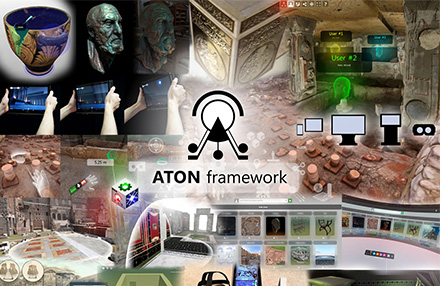Service: ATON - Web3D services for Heritage Science
Platforms
Digilab
Techniques
Data presentation
Data processing
Data visualization
Digital archiving service
Digital resource utilization

Organization
Service contact persons
ATON is a service accessible to everyone for presenting and interacting with 3D models, scenes, and 360 panoramas directly on the web. It is designed to meet the growing demand for 3D digitization in Cultural Heritage.
The core open-source framework allows to present and interact with 3D models and scenes on the web, primarily targeting Heritage Science communities. Its adaptive presentation layer allows interactive, liquid 3D visualization - ranging from mobile devices, museum kiosks, workstations, up to immersive XR devices - without any installation required for final users.
The adoption of robust open-source ecosystems and international standards, alongside a REST API, maximize interoperability and integration with other platforms and services. It requires no installation for end users since a common web browser is sufficient to access interactive content, automatically adapting to any device (smartphones, tablets, computers, museum kiosks, up to AR/VR devices).
Key features to interact with 3D contents include measuring tools, semantic annotations, layers, virtual tours creation, immersive AR/VR presentation, real-time collaboration with other remote users, advanced illumination tools and simulation of complex materials, and much more. Furthermore, it offers different navigation modes: orbit, first-person, device orientation – besides various features for viewpoints management.
The service offers public access to research institutes, laboratories, museums, experts and researchers, willing to rapidly integrate interactive 3D tools into their workflows. User-friendly interfaces, modular components and multi-user capabilities allow wide customizations for different use cases. Furthermore, a plug&play architecture provides an accelerator for development and deployment of cross-device and interoperable Web3D/WebXR applications or pilots.
Selected proposals will also receive technical and scientific support for their project, alongside the plug&play PWA model: it allows applicants to develop custom Web3D/WebXR vertical solutions and deploy directly on the service node.
Fields of application
Archaeology
Architecture (discipline)
Conservation science (cultural heritage discipline)
Heritage science (cultural heritage discipline)
Other information
-
Input: 3D models, point clouds, panoramic 360 content

